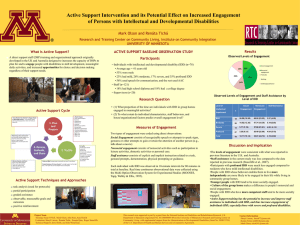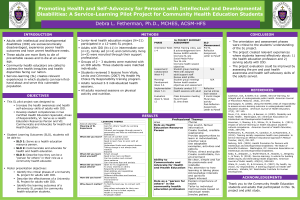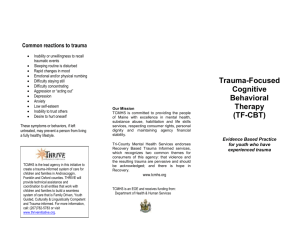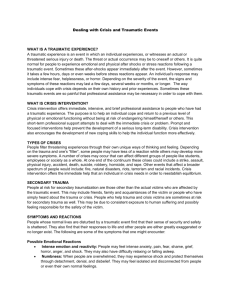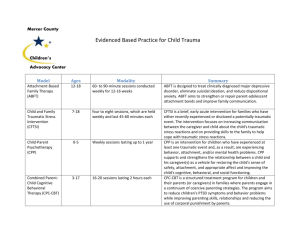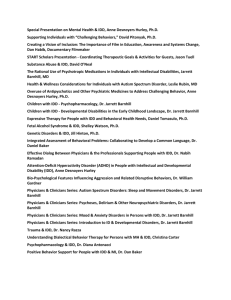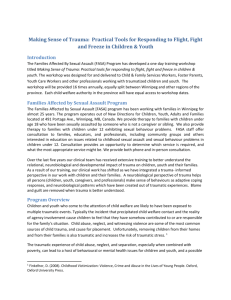handout
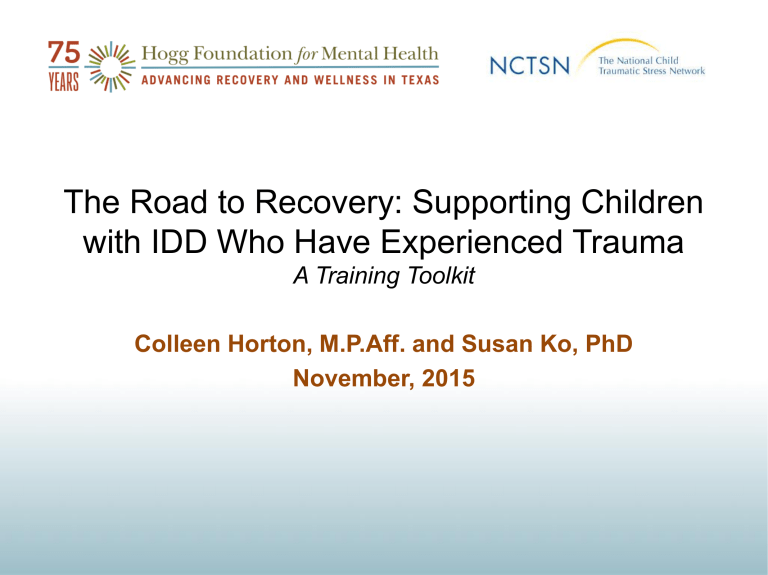
The Road to Recovery: Supporting Children with IDD Who Have Experienced Trauma
A Training Toolkit
Colleen Horton, M.P.Aff. and Susan Ko, PhD
November, 2015
Goal:
Understand that children with intellectual/developmental disabilities (IDD) experience mental health conditions.
Understand the various ways that children with IDD experience trauma.
Understand the impact of trauma on children with IDD.
Understand the importance of trauma-informed care for children with IDD.
Understand how the toolkit can be used to improve provider/caregiver capacity for provision of trauma-informed care for children with IDD.
Why is this important to children with
IDD and those supporting them?
High rates of abuse and neglect including physical, sexual and emotional
High rates of bullying
Victims of violent crimes
Family stress can turn into family violence
Institutionalization
Abandonment and isolation
Restraint and seclusion
What mental health conditions do people with IDD experience?
The same mental health conditions as anyone else including depression, schizophrenia, bi-polar, anxiety, compulsive disorders, post-traumatic stress, and other serious emotional disturbances.
What are we doing now?
We typically attribute “challenging behaviors” to the disability.
We try to manage behaviors often through some type of authority/control/compliance model.
We focus on challenging behaviors and crisis intervention instead of the mental health and wellness of people with IDD.
Why is it that when your IQ is over 75 you have a “mental health condition” that need assessment and treatment, but if your IQ is low you have “behaviors” that need managing?
Focus on recovery
Develop a recovery focused approach to care for people with cooccurring IDD and mental health conditions. We know that people living with mental illness can recover.
The Substance Abuse and Mental Health Services Administration
(SAMSHA) defines recovery as “A process of change through which individuals improve their health and wellness, live a self-directed life, and strive to reach their full potential.”
The mental health system in many states is recovery-based.
However, the principles of recovery have not been incorporated into systems of care for people with IDD.
http://www.samhsa.gov/newsroom/advisories/1112223420.aspx
Ingredients Necessary for Recovery
(K. Harvey)
Perceived
Safety
Empowerment Connection
Barriers to Recovery
Historic behavior management models rarely offer the opportunity for a sense of safety, meaningful relationships, or empowerment.
Instead, we focus on behaviors that we assume are the result of the disability (overshadowing).
We try to alleviate the maladaptive behaviors instead of trying to treat underlying mental illness or trauma.
We continue to focus on “what’s wrong” with the individual instead of asking “what happened to you” and, “how did what happened to you affect you?”
What about trauma?
What is a traumatic event?
Trauma comes in many forms. Traumatic experiences can include: abuse and/or neglect, witnessing violence, abandonment or the loss of a loved one, traumatic grief, bullying, a traumatic event such as a natural disaster or car accident, painful medical treatment, school violence and more.
Trauma can be cumulative with the impact building or can be episodic. Exposure to trauma often impacts development.
Trauma can change an individual’s sense of safety and how they perceive the actions of others – even those trying to help them.
Trauma impacts development and mental wellness.
Impact of trauma exposure on children
(National Child Traumatic Stress Network)
The world is uncertain and unpredictable; creates problems with boundaries and distrust; can cause social isolation.
Increases stress hormones changing the brain chemistry. Can cause hypersensitivity to physical touch. May cause unexplained physical health problems.
Causes difficulty in regulating emotions, difficulty in describing feelings, wishes and desires to others.
Creates feelings of detachment, withdrawal, amnesia-like state.
Impact on children (continued)
Causes poor impulse control, self-destructive behavior, aggression, sleep disorders and eating disorders.
Causes problems with focusing and completing tasks, difficulty with planning, learning difficulties and language development.
Instills a lack of predictable sense of self, low self-esteem, shame and guilt.
Causes problems with emotional regulation and over-controlled or under-controlled behavior.
The science of trauma
When trauma occurs or past traumas are triggered, the brain reverts to its reptilian stage of survival.
Fight
Flight
Freeze
Person perceives that he/she is in danger.
Rational mind shuts down and reverts to survival mode.
This is not a teachable moment!
The Behavioral Pyramid
(K. Harvey)
Behavioral Issues:
• Emotions Expressed
• Often Rooted in Trauma
BEHAVIOR
EMOTION
TRAUMA
When we only address the behavior, we miss the true cause and root of difficulties. (K. Harvey)
Challenges in assessing, diagnosing and treating mental illness in people with IDD
Overshadowing
Communication challenges
Lack of expertise in both the mental health field and in the IDD field
Extended time it takes to assess (requires talking to more than just the patient; must interview critical caregivers, family, etc.)
Professional biases – belief that evidence-based mental health treatments don’t work on this population
Challenges (continued)
Mental health workforce shortage – especially expertise with people with IDD.
Lack of cross-agency coordination
Treating the behavior instead of the underlying mental health or medical condition; ease of using medication
Failure to address the impact of past trauma
Lack of consideration of people with IDD in state mental health policy
People with IDD deserve the same state-of-the-art mental health treatment as everyone else.
What is trauma-informed care?
Recognizes the impact of trauma on an individual’s development, behavior, mental and physical well-being.
Recognizes the need for people to feel safe.
Recognizes the impact of trauma on the caregivers.
Often requires a re-direction of our thinking.
Now available! Training Toolkit for Trauma-Informed Care for
Children with Intellectual/Developmental Disabilities developed by the
National Child Traumatic Stress Network and the Hogg Foundation for Mental Health.
The Road to Recovery:
Supporting Children with IDD Who Have Experienced Trauma
Components of the Toolkit
About this Toolkit
Facilitator Guide
Videos
Participant Manual
Case Vignettes
Board Game/Activities
Slide Kit
Supplemental Materials
18
Who is the target audience?
IDD
Mental
Health
Trauma
19
Pilot History
Meridian Health Services in Muncie & Mishawaka,
Indiana in June 2015
Hogg Foundation for Mental Health in Austin, Texas in July 2015
Depelchin Children’s Services in Houston, Texas in
July 2015
Train-the-trainer in Redondo Beach, CA in August
2015
20
Module One: Setting the Stage
Module Two: Development, IDD & Trauma
Module Three: Traumatic Stress Responses in Children with IDD
Module Four: Child & Family Well-Being & Resilience
Module Five: IDD- & Trauma-Informed Services & Treatment
Module Six: Provider Self-Care
Module One: Learning Objectives
What Will I Learn Today?
1.
2.
3.
4.
Recognize that children with IDD are at-risk for traumatic experiences.
Articulate that recovery from traumatic experiences is possible.
Establish the important role of parents/caregivers and families on the road to recovery.
Describe frameworks that will be used to highlight key concepts throughout the training.
The Risk & Protective Factors Model
Supportive School &
Community Environment
Social Skills
Family Cohesion
Adaptive Coping Skills
Self Efficacy
Secure Attachment
Mentors
Healing & Protective Environment
Social
Support
23
Essential Messages of Working with Children with IDD who have Experienced Trauma
Know that there’s hope; recovery from traumatic experiences is possible.
Recognize that a child with IDD may have had a traumatic experience(s), which can have profound effects.
24
What Can a Provider Do?
Create a learning climate/culture —honor the child’s, parent’s and provider’s experience.
Identify any fears or biases I have about working with children with IDD who have had traumatic experiences.
Identify ways to increase my knowledge & skills.
Providers
Family
Child
Module One: Setting the Stage
Module Two: Development, IDD & Trauma
Module Three: Traumatic Stress Responses in Children with IDD
Module Four: Child & Family Well-Being & Resilience
Module Five: IDD- & Trauma-Informed Services & Treatment
Module Six: Provider Self-Care
26
26
Module Two: Learning Objectives
What Will I Learn Today?
1.
Define IDD and various types of disabilities.
2.
Discuss developmental tasks across typical development.
3.
4.
Describe how IDD and traumatic experiences may disrupt typical development.
Identify the areas in which children’s functioning is affected by IDD & subsequent adaptations that must be made.
27
Introducing…
Ivana is an 18-month-old infant who was adopted at birth from Russia.
Suzie is a 4-year-old living with her family in San Francisco.
Joshua is a 6-year-old living with his family on the Upper West Side of
Manhattan.
Steven is a 10-year-old living with his family at Camp Pendleton in San
Diego.
Jacqueline is a 16-year-old who lives with her grandmother in Laredo,
Texas.
Justin is a 19-year-old living with his adoptive parents in Detroit.
28
!
Essential Messages
3.
Recognize a child’s developmental level and how IDD and traumatic experiences are affecting his/her functioning.
4. Utilize a developmental lens when making meaning of a child’s traumatic experiences & responses.
What Can a Provider Do?
Ask questions and gather information (formally or informally) to understand the child’s developmental age & how IDD is affecting his/her functioning.
Identify IDD-related support needs of children & families.
Identify how living with IDD is affecting the quality of the child’s life.
Providers
Family
Child
Module One: Setting the Stage
Module Two: Development, IDD & Trauma
Module Three: Traumatic Stress Responses in Children with IDD
Module Four: Child & Family Well-Being & Resilience
Module Five: IDD- & Trauma-Informed Services & Treatment
Module Six: Provider Self-Care
31
31
Module Three: Learning Objectives
What Will I Learn Today?
1.
Define child traumatic stress and PTSD.
2.
3.
Describe the 12 Core Concepts for understanding traumatic stress responses in children and families.
Identify how traumatic experiences and their responses affect children with IDD.
32
What is Child Traumatic Stress?
Personally experiencing or witnessing a real or perceived threat to emotional/physical well-being
Intensity & seriousness of the experience registers in child’s body & mind
Reactions that persist and interfere with the ability to function even after the traumatic events have ended
Ongoing pattern of symptoms may be diagnosed as
PTSD
Not every child who experiences a traumatic event will develop symptoms of child traumatic stress.
33
Types of Traumatic Experiences
Single traumatic experience (e.g., serious car accident, disasters)
Experiences that occur together (e.g., domestic violence & physical abuse)
Experiences that can extend over time
(e.g., sexual abuse)
Experiences that are a mixture of the above
Pre-trauma
Traumatic
Experience
Post-
Trauma
34
Core Concept 1: Complexity
“There’s a lot going on in the child’s mind and body.”
For a family & child with IDD
Moment-to-moment reactions can be even more complex due to physical, cognitive or communicative limitations that impact the range of protective actions that were possible during the traumatic experience.
35
35
!
Essential Message
5.Recognize that in the aftermath of trauma, understanding traumatic stress responses is the first step in helping children regain their sense of safety, value and quality of life.
36
What Can a Provider Do?
Learn about a child’s moment-to-moment reactions during a traumatic event.
Learn about the child-intrinsic and child-extrinsic factors that comprise the ecology within which the trauma occurred.
Ask about trauma reminders.
Ask children and parents how their perceptions of danger and safety may have changed following the traumatic experience.
Explore how the cultural background of the child and family may be influencing responses to the traumatic experience.
Ask if the child/family are involved with social institutions.
Providers
Family
Child
37
Module One: Setting the Stage
Module Two: Development, IDD & Trauma
Module Three: Traumatic Stress Responses in Children with IDD
Module Four: Child & Family Well-Being & Resilience
Module Five: IDD- & Trauma-Informed Services & Treatment
Module Six: Provider Self-Care
38
Module Four: Learning Objectives
What Will I Learn Today?
1.
2.
3.
4.
Explore the impact on parents/caregivers of learning about their child’s traumatic experience.
Explain strategies for strengthening protective factors to enhance child and family well-being, resilience and recovery.
Describe frameworks for promoting a healing and protective environment in order to create a safe and meaningful life for children.
Identify family-informed, child-centered planning techniques to help children realize their hopes and dreams.
39
Adapted from: The Life Course
Game that was created and developed by CityMatCH. http://www.citymatch.org:8080/lifeco ursetoolbox/gameboard.php
Putting It Into Practice
40
!
Essential Messages
6. Utilize an IDD- & trauma-informed child-centered approach to support both the child & the family.
7. Help parents/caregivers, and other professionals in the child’s life, strengthen protective factors.
41
What Can a Provider Do?
Identify and enhance family strengths and natural supports.
Ask about siblings.
Take the time to listen to parents/caregivers and ask them what about their questions, concerns & challenges.
Provide practical tools for promoting a secure attachment and a healing & protective environment.
Provide anticipatory guidance.
Help parents/caregivers access support.
Help parents find access to respite care.
Providers
Family
Child
42
Module One: Setting the Stage
Module Two: Development, IDD & Trauma
Module Three: Traumatic Responses in Children with IDD
Module Four: Child & Family Well-Being & Resilience
Module Five: IDD- & Trauma-Informed Services & Treatment
Module Six: Provider Self-Care
43
Module Five: Learning Objectives
What Will I Learn Today?
1.
2.
3.
4.
Explain how to enhance protective factors of children with IDD & families through appropriate trauma-informed services & treatment.
Discuss how to utilize adapted screening, assessment & planning tools to identify IDD- & trauma-informed needs of children & families.
Discuss strategies for adapting the core components of traumainformed treatments for children with IDD.
Identify strategies for partnering with agencies & cross-system collaboration.
44
!
Essential Messages
8.Partner with agencies and systems to ensure earlier and more sustained access to services.
9.Ensure that trauma-informed child-centered services, treatments and systems drive the recovery plan.
45
What Can a Provider Do?
Identify the developmental level of the child in order to guide appropriate selection of trauma screening/assessment tools, services & treatments.
Coordinate continuous care through communication with therapists and other providers on a regular basis.
Participate in cross-training with other agencies and systems on issues related to child trauma and traumainformed care.
Identify and interview local individuals/agencies
Providers
Family
Child
46
Module One: Setting the Stage
Module Two: Development, IDD & Trauma
Module Three: Traumatic Stress Responses in Children with IDD
Module Four: Child & Family Well-Being & Resilience
Module Five: IDD- & Trauma-Informed Services & Treatment
Module Six: Provider Self-Care
47
Module Six: Learning Objectives
What Will I Learn Today?
1.
Describe the difference between secondary traumatic stress, burnout and vicarious trauma.
2.
Identify how burnout develops among providers.
3.
Discuss potential sources, warning signs, and effects of secondary traumatic stress and organizational stress.
4.
Implement steps to stress reduction and self-care.
48
!
Essential Message
10.Practice ongoing self-care in order to increase effectiveness in delivering high quality support, services and treatment.
49
What Can a Provider Do?
Identify potential sources, warning signs and effects of STS and organizational stress.
Identify strategies for stress reduction.
Practice the ABC’s of self-care.
Identify wellness activities that could be provided in your organization.
Identify selfcare resources that you’d like to explore further.
Providers
Family
Child
50
The Road to Recovery Toolkit: Available on the NCTSN Learning Center
Includes
Facilitator Guide
PPT Slides
NCTSN videos
Board Game files
Sample agenda
Pre-Training and Follow-Up Evaluations (PDF versions) & links to online Qualtrics versions
Designed to promote communication between a community of facilitators where information & training events can be shared
Identify strategies for stress reduction.
Practice the ABC’s of self-care.
Identify wellness activities that could be provided in your organization.
Identify selfcare resources that you’d like to explore further.
51
What’s Next?
Make trauma-informed care for children with IDD a national conversation
Find ways in your state to get the training started.
Change the culture of care for kids with IDD – it’s not just about controlling behaviors.
What needs to be done?
Cross-agency collaboration – Agencies must work more closely to identify the mental health needs of those with IDD and take joint responsibility for meeting those needs.
Create a cross-agency mental health unit/division for people with IDD. This division should build capacity for high quality standards, prevention, treatment and crisis support and services including crisis intervention teams.
Recognize that substantial improvement is needed.
Prioritize the development of expertise and capacity across agencies.
Promote the use of non-pharmacological treatment
– psycho-social, behavioral, and cognitive therapies.
Increase expectations that people with IDD will receive quality mental health services by developing standards of care in policies and practices that are recovery-based.
Focus on trauma-informed care.
What needs to be done?
Crisis intervention programs
Crisis Response Teams – Crisis response teams that currently exist to support individuals experiencing a mental health crisis should be trained to provide crisis intervention to people with intellectual disabilities. Additionally, specialized crisis teams should be developed in each region to provide direct emergency services to people with IDD and to support other city and county crisis response teams.
Emergency respite options – Currently, the only residential supports that exist for someone with IDD in crisis are hospitals, psychiatric hospitals or
SSLCs – all of which are extremely costly. Making respite available to individuals in crisis allows opportunities for the individual, the family and the support team to stabilize, assess and develop a plan for recovery.
What do WE need to do?
Question current behavior management practices.
Ask more questions of professionals, i.e., “have you considered depression, anxiety or trauma?” Force professionals to consider the possibility of underlying mental health or medical conditions.
Stop looking for “what’s wrong” with people and start asking “what has happened to them.”
Move from a culture of control and compliance to one of respect and support.
Look at current behavior management practices to determine if trauma is being exacerbated.
What else?
Demand trauma-informed care training for IDD and mental health professionals.
Demand trauma-informed care and other evidence-based mental health treatment and practices including early identification and treatment.
Start asking different questions – force others to think about the mental health of individuals with IDD.
Don’t settle for the status quo.
Request better assessments.
Demand better treatment.
Continuing the conversation…
Look for opportunities to include the mental health needs of people with IDD in broader discussions – schools, waiver programs, parent trainings.
It’s logical, don’t feel you have to be a clinician or scientist to make sense of this. Many of us have lived it.
When filling out evaluations at trainings, workshops, etc., stress the need to include mental health for people with IDD in future programs and agendas.
Talk to policy makers. Demand that the IDD population be included in other mental health systems planning.
Now is the time!
Hogg Foundation Efforts
Public Policy Priority
Two-year trauma-informed care training and technical assistance grant at two state supported living centers to reduce the use of restraint.
Partnership with the National Child Traumatic Stress Network to develop a training toolkit for trauma-informed care for children with
IDD.
Funded a research project with EveryChild, Inc. to research and promote positive behavior supports.
Worked with legislature to require state agency provide traumainformed care training for individuals residing in ICFsIDD.
Approach foundations and agencies in your state!
Additional Resources
National Child Traumatic Stress Network – Child Welfare Trauma
Training Toolkit, Trauma Training Toolkit for Workers in the
Juvenile Justice System, and much, much more.
Karyn Harvey, Ph.D. -Positive Identity Development
NADD – National Association of People with Developmental Disabilities and Mental Health Challenges, www.nadd.org
Center for Disease Control and Prevention
Adverse Childhood Experiences (ACE) Study http://www.cdc.gov/ace/index.htm
Contact Information:
Colleen Horton, MPAff.
Hogg Foundation for Mental Health at The
University of Texas at Austin colleen.horton@austin.utexas.edu
Susan Ko, PhD
National Center for Child Traumatic Stress
UCLA Neuropsychiatric Institute and Hospital sko@mednet.ucla.edu
www.NCTSN.org
http://learn.nctsn.org
